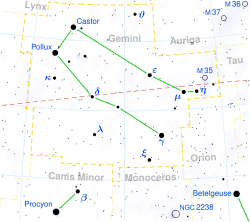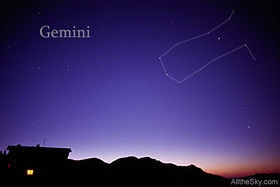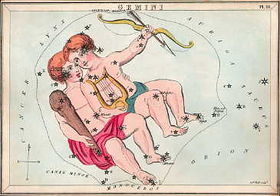Gemini (constellation)
| Constellation | |
 List of stars in Gemini |
|
| Abbreviation | Gem |
|---|---|
| Genitive | Geminorum |
| Pronunciation | /ˈdʒɛmɨnaɪ/, genitive /ˌdʒɛmɨˈnɒrəm/ |
| Symbolism | the Twins, Castor & Pollux |
| Right ascension | 7 h |
| Declination | +20° |
| Quadrant | NQ2 |
| Area | 514 sq. deg. (30th) |
| Main stars | 8, 17 |
| Bayer/Flamsteed stars |
80 |
| Stars with planets | 3 |
| Stars brighter than 3.00m | 4 |
| Stars within 10.00 pc (32.62 ly) | 4 |
| Brightest star | Pollux (β Gem) (1.15m) |
| Nearest star | Gliese 251 (17.99 ly, 5.52 pc) |
| Messier objects | 1 |
| Meteor showers | Geminids Rho Geminids |
| Bordering constellations |
Lynx Auriga Taurus Orion Monoceros Canis Minor Cancer |
| Visible at latitudes between +90° and −60°. Best visible at 21:00 (9 p.m.) during the month of February. |
|
Gemini is one of the constellations of the zodiac. Its name is Latin for "twins", and it is associated with the twins Castor and Pollux in Greek mythology. Its symbol is ![]() (Unicode ♊). It lies between Taurus to the west and Cancer to the east, with Auriga and Lynx to the north and Monoceros and Canis Minor to the south.
(Unicode ♊). It lies between Taurus to the west and Cancer to the east, with Auriga and Lynx to the north and Monoceros and Canis Minor to the south.
Contents |
Location

In October and November Gemini will appear along the eastern horizon in the morning sky prior to sunrise. The best time to observe Gemini at night is overhead during the months of January and February. By April and May, the constellation will be visible soon after sunset in the west.
The easiest way to locate the constellation is to find its two brightest stars Castor and Pollux eastward from the familiar “V” shaped asterism of Taurus and the three stars of Orion’s belt. Another way is to mentally draw a line from the Pleiades star cluster located in Taurus and the brightest star in Leo, Regulus. In doing so, you are drawing an imaginary line that is relatively close to the ecliptic, a line which intersects Gemini roughly at the midpoint of the constellation, just below Castor and Pollux. (Note: the thin red line {- - - -} in the above constellation map is a graphic representation of the ecliptic.)
Notable features
Stars
The most notable stars in Gemini are Castor and Pollux. Although Castor has the Bayer designation Alpha, it is actually the second brightest star in the constellation after Pollux. Castor has the unique distinction of being a sextuple star system. One of the distinguishing characteristics of Pollux on the other hand is that it was recently discovered to have an extrasolar planet revolving around it.
There are in fact 3 stars in Gemini that have been identified as having exoplanets: Pollux, HD 50554, and HD 59686. Another star that is noteworthy is Mekbuda (ζ Gem) — a supergiant with a radius that is 60 times solar, making it approximately is 220,000 times the size of the Sun.
Deep sky objects
Given that Gemini is pointing away from the Milky Way, there are relatively few deep sky objects of note: Messier object M35, the Eskimo Nebula, and Geminga. M35 is an open star cluster which was discovered in the year 1745 by Philippe Loys de Chéseaux. The Eskimo Nebula, otherwise known as NGC 2392, is a beautiful planetary nebula approximately 2,870 light years away. And Geminga is a neutron star approximately 550 light years from Earth. Other objects of note are NGC 2129, NGC 2266, NGC 2331, NGC 2355, and NGC 2395.
Visualizations
Gemini is dominated by Castor and Pollux, two bright stars that appear relatively close together, encouraging the mythological link between the constellation and twinship. The twin to the right is Castor, whose brightest star is α Geminorum (more commonly called Castor); it is a second magnitude star and represents Castor's head. The twin to the left is Pollux, whose brightest star is β Geminorum (more commonly called Pollux); it is of the first magnitude and represents Pollux's head. Furthermore, the other stars can be visualized as two parallel lines descending from the two main stars, making it look like two figures.
H.A. Rey has suggested an alternative to the traditional visualization that connected the stars of Gemini to show a pair of twins holding hands. Pollux's torso is represented by star υ Geminorum, Pollux's right hand by ι Geminorum, Pollux's left hand by κ Geminorum: all three of these stars are of the fourth magnitude. Pollux's pelvis is represented by star δ Geminorum, Pollux's right knee by ζ Geminorum, Pollux's right foot by γ Geminorum, Pollux's left knee by λ Geminorum, and Pollux's left foot by ξ Geminorum. Gamma Geminorum is of the second magnitude, while delta and xi Geminorum are of the third magnitude. Castor's torso is represented by the star τ Geminorum, Castor's left hand by ι Geminorum (which he shares with Pollux), Castor's right hand by θ Geminorum: all three of these stars are of the fourth magnitude. Castor's pelvis is represented by the star ε Geminorum, Castor's left foot by ν Geminorum, and Castor's right foot by μ Geminorum and η Geminorum: ε, μ, and η Geminorum are of the third magnitude.
Mythology

Gemini was associated with the myth of Castor and Pollux, collectively known as the Dioscuri. One myth of these twins concerns cattle theft, and may be connected to earlier myths that described the Milky Way as a herd of dairy cows. On star maps, the twins are usually viewed as leaning away from the Milky Way, but are sometimes depicted with one of the twins residing in the Milky Way, and the other outside it, a situation making it appear that one of the twins is stealing the cattle, and the other is observing. Along with the other features of the area in the Zodiac sign of Gemini (i.e. Orion, Auriga, and Canis Major), this may be the origin of the myth of the cattle of Geryon, which forms one of The Twelve Labours of Heracles. When Castor died because he was mortal, Pollux begged his father Jupiter to give Castor immortality and he did, by uniting them together in the heavens.
Astrology
As of 2008[update], the Sun appears in the constellation Gemini from June 20 to July 20. In tropical astrology, the Sun is considered to be in the sign Gemini from May 21 to June 20, and in sidereal astrology, from June 16 to July 15.
See also
- Messier 35 open cluster
- Geminga, Gemini gamma-ray source
References
- H. A. Rey, The Stars — A New Way To See Them. Enlarged World-Wide Edition. Houghton Mifflin, Boston, 1997. ISBN 0-395-24830-2.
- Ian Ridpath and Wil Tirion (2007). Stars and Planets Guide, Collins, London. ISBN 978-0007251209. Princeton University Press, Princeton. ISBN 978-0691135564.
External links
- The Deep Photographic Guide to the Constellations: Gemini
- The clickable Gemini
- wikisky.org: Gemini constellation
- Star Tales – Gemini
|
||||||||||||||
|
|||||
|
||||||||||||||||||||||||||||||||
| Astronomy | Constellations of the Zodiac |
|---|
| Pisces ★ Aries ★ Taurus ★ Gemini ★ Cancer ★ Leo ★ Virgo ★ Libra ★ Scorpius ★ Ophiuchus ★ Sagittarius ★ Capricornus ★ Aquarius |